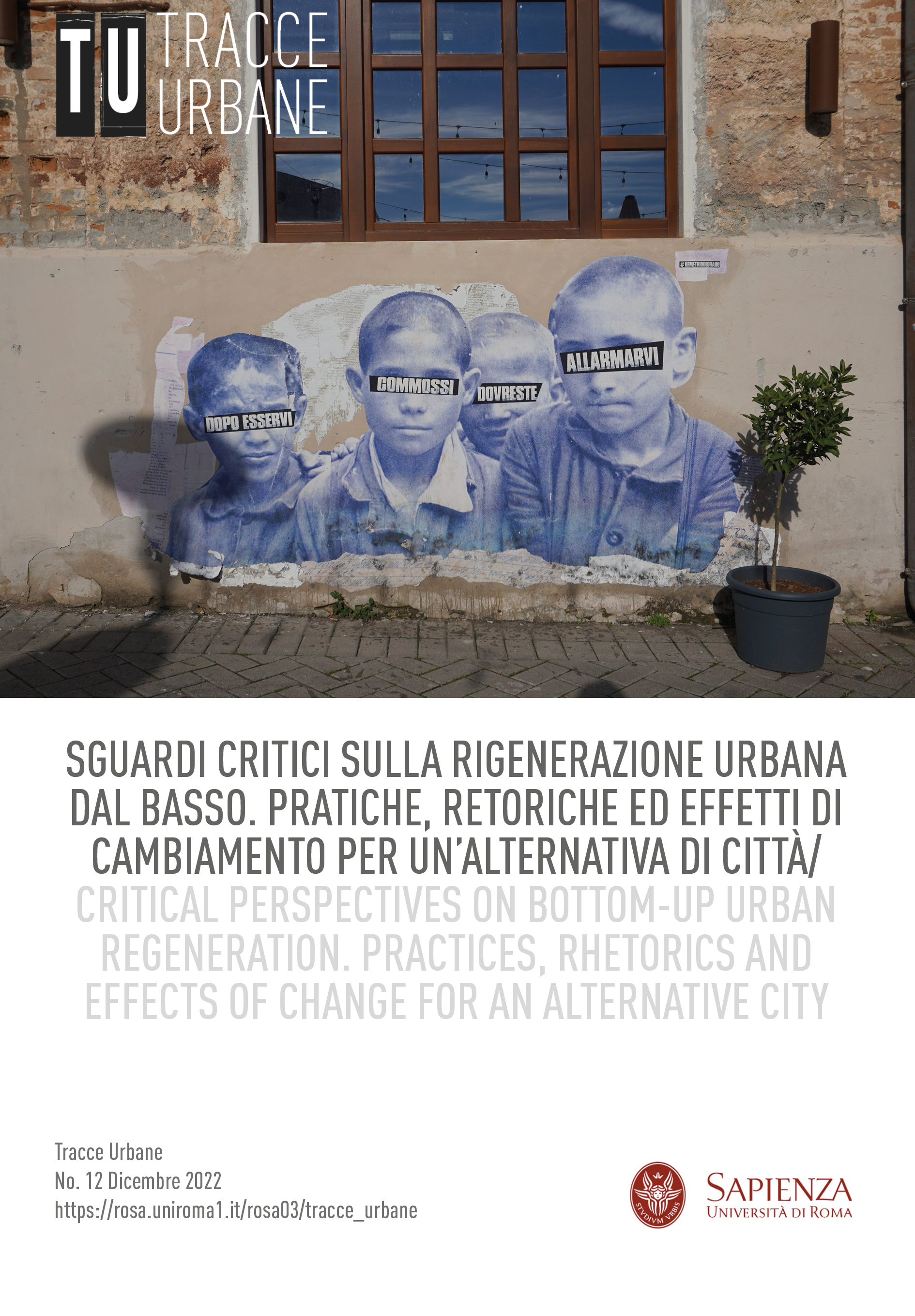Critical reflecting on the meaning of bottom-up urban practices for authentic inclusivity: the case of San Berillo in Catania
DOI:
https://doi.org/10.13133/2532-6562/18134Keywords:
grassroots urban regeneration, marginalized neighborhood, historic centerAbstract
This paper addresses the debate on inclusive grassroot urban regeneration, and it aims to contribute by offering critical insights into how some specificities of context can limit the effectiveness of the action processes from below. In particular, through her experience in the San Berillo neighborhood in the historic center of the city of Catania, the author intends to focus on those central suburbs characterized by ‘structural marginality’, the need of invisibility of some inhabitants, the coexistence of different subjectivities, and therefore ‘multiple grassroots’, often conflicting and a strong institutional weakness. In order to enrich the debate, and to propose ideas for reflection on the construction of public policies, this article explores these specificities of context and highlights how in neighborhoods characterized by substantial socio-spatial inequalities and institutional weakness, the grassroot regeneration struggles to promote inclusive processes.
References
Annunziata S. (2008). «Se tutto fosse gentrification: possibilità e limiti di una categoria descrittiva». In Balducci A., Fedeli V., a cura di, I territori della città in trasformazione: tattiche e percorsi di ricerca. Milano: FrancoAngeli.
Annunziata S., Lees L. (2016). «Resisting austerity gentrification in Southern European cities». Sociological Research Online, 21: 148-155. DOI: 10.5153/sro.4033.
Barbanti C., Privitera E. (2020). «Riabitare l’esistente come risposta al disagio sociale. Sperimentazioni sull’abitare collaborativo nel quartiere di San Berillo a Catania». In AA. VV. (2020), Atti della XXII Conferenza Nazionale SIU. L'Urbanistica italiana di fronte all’Agenda 2030. Portare territori e comunità sulla strada della sostenibilità e della resilienza. Roma-Milano: Planum Publisher.
Blanco I., Bonet J., Walliser A. (2011). «Urban governance and regeneration policies in historic city centres: Madrid and Barcelona». Urban Research & Practice, 4: 326-343. DOI: https://doi.org/10.1080/17535069.2011.616749.
Borzaga C., Mori P., Salvatori G., Sforzi J., Zandonai F (2016). Libro Bianco: La cooperazione di Comunità. Trento: Euricse. Disponibile a: https://euricse.eu/wp-content/uploads/2016/05/Libro-Bianco.pdf
Bricocoli M., Peverini M., Tagliaferri A. (2021). Cooperative e case popolari. Il caso delle Quattro Corti a Milano. Padova: Il Poligrafo.
Busacca P., Gravagno F. (2004). L’occhio di Arlecchino. Schizzi per il quartiere San Berillo a Catania. Roma: Gangemi.
Calvaresi C., Pacchi C., Zanoni D. (2015). «Innovazione dal basso e imprese di comunità». Rivista impresa sociale, 5: 44-52. Disponibile a: https://www.rivistaimpresasociale.it/rivista/articolo/innovazione-dal-basso-e-imprese-di-comunita.
Cellamare C. (2008). Fare città. Pratiche urbane e storie di luoghi. Milano: Elèuthera.
Cellamare C. (2019). «Rigenerare dal basso. Capacità di riuso e gestione innovativi nei quartieri in difficoltà della periferia romana». In AA.VV. (2019), Atti della XXI Conferenza Nazionale SIU. Confini, Movimenti, Luoghi. Politiche e progetti per città e territori in transizione. Roma-Milano: Planum Publisher.
Ciampolini T., a cura di (2019). Comunità che innovano: Prospettive ed esperienze per territori inclusivi. Franco Angeli, Milano.
Cruz H., Rubén Martínez M., Blanco I. (2017). «Crisis, Urban Segregation and Social Innovation in Catalonia». PArtecipazione e COnflitto, 10: 221-245. DOI: 10.1285/i20356609v10i1p221.
Dewey J. (1971). The public and its problems: An essay in political inquiry. University Park: Pennsylvania State University Press.
Donolo C. (1997). L’intelligenza delle istituzioni. Milano: Feltrinelli.
D’Urso A., Reina G., Reutz-Hornsteiner B., Ruiz Peyré F., a cura di, (2013). Urban Cultural Maps. Condividere, partecipare, trasformare l’urbano. Catania: C.U.E.C.M.
Lanzara, G. F. (1997). «Perché è difficile costruire le istituzioni». Rivista Italiana di Scienza Politica, 27:3-48. DOI: https://doi.org/10.1017/S0048840200025521.
Lefebvre H. (1968). Le Droit à la ville. Parigi: Éd. Anthropos (trad. it. 2014, Il diritto alla città. Verona: Ombre corte).
Moulaert F., MacCallum D., Hillier J. (2013). «Social innovation: Intuition, precept, concept, theory and practice». In F. Moulaert, D. MacCallum, A. Mehmood, & A. Hamdouch, The International Handbook on Social Innovation: 13-24. Cheltenham: Edward Elgar Publishing. DOI: https://doi.org/10.4337/9781849809993.00011.
Mills C. W. (1959). The Sociological Imagination. Oxford: Oxford University Press.
Mori P. A. (2015). «Comunità e cooperazione: l’evoluzione delle cooperative verso nuovi modelli di partecipazione democratica dei cittadini alla gestione dei servizi pubblici». Euricse Working Papers, 77|15. Disponibile a: https://euricse.eu/wp-content/uploads/2015/08/WP-77_15_Mori.pdf.
Ostanel E. (2017). Spazi fuori dal comune. Rigenerare, includere, innovare. Milano: Franco Angeli.
Saija L. (2017). «Autobiography as a Method of Inquiry». In: Haselsberger, B. (ed), Encounters in planning thought: 16 autobiographical essays from key thinkers in spatial planning. New York: Routledge, Taylor & Francis Group.
Swyngedouw E. (2007). «The post-political city». In: BAVO (ed), Urban Politics Now: Re-Imagining Democracy in the Neo-Liberal City. Rotterdam: Netherland Architecture Institute (NAI)-Publishers, pp. 58-76.
Tricarico L. (2014). «Imprese di Comunità nelle Politiche di Rigenerazione Urbana: Definire ed Inquadrare il Contesto Italiano». Euricse Working Papers, 68|14. Disponibile a: http://bit.ly/2sEonai.
Tulumello S., Allegretti G. (2021). «Articulating urban change in Southern Europe: Gentrification, touristification and financialisation in Mouraria, Lisbon». European Urban and Regional Studies, 28: 111-132. DOI: https://doi.org/10.1177/0969776420963381.
Venturi P., Zandonai, F. (2019). Dove. La dimensione di luogo che ricompone impresa e società. Milano: Egea.
Downloads
Published
How to Cite
Issue
Section
License
Copyright (c) 2022 Carla Barbanti

This work is licensed under a Creative Commons Attribution 4.0 International License.
NOTA DI COPYRIGHT
Proposta di licenza Creative Commons
1. Proposta per riviste Open Access
Gli autori che pubblicano su questa rivista accettano le seguenti condizioni:
Gli autori mantengono i diritti sulla loro opera e cedono alla rivista il diritto di prima pubblicazione dell'opera, contemporaneamente licenziata sotto una Licenza Creative Commons - Attribuzione che permette ad altri di condividere l'opera indicando la paternità intellettuale e la prima pubblicazione su questa rivista.
Gli autori possono aderire ad altri accordi di licenza non esclusiva per la distribuzione della versione dell'opera pubblicata (es. depositarla in un archivio istituzionale o pubblicarla in una monografia), a patto di indicare che la prima pubblicazione è avvenuta su questa rivista.
Gli autori possono diffondere la loro opera online (es. in repository istituzionali o nel loro sito web) prima e durante il processo di submission, poiché può portare a scambi produttivi e aumentare le citazioni dell'opera pubblicata (Vedi The Effect of Open Access).


